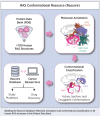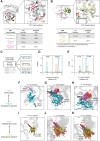Delineating the RAS Conformational Landscape
- PMID: 35536216
- PMCID: PMC9256797
- DOI: 10.1158/0008-5472.CAN-22-0804
Delineating the RAS Conformational Landscape
Abstract
Mutations in RAS isoforms (KRAS, NRAS, and HRAS) are among the most frequent oncogenic alterations in many cancers, making these proteins high priority therapeutic targets. Effectively targeting RAS isoforms requires an exact understanding of their active, inactive, and druggable conformations. However, there is no structural catalog of RAS conformations to guide therapeutic targeting or examining the structural impact of RAS mutations. Here we present an expanded classification of RAS conformations based on analyses of the catalytic switch 1 (SW1) and switch 2 (SW2) loops. From 721 human KRAS, NRAS, and HRAS structures available in the Protein Data Bank (206 RAS-protein cocomplexes, 190 inhibitor-bound, and 325 unbound, including 204 WT and 517 mutated structures), we created a broad conformational classification based on the spatial positions of Y32 in SW1 and Y71 in SW2. Clustering all well-modeled SW1 and SW2 loops using a density-based machine learning algorithm defined additional conformational subsets, some previously undescribed. Three SW1 conformations and nine SW2 conformations were identified, each associated with different nucleotide states (GTP-bound, nucleotide-free, and GDP-bound) and specific bound proteins or inhibitor sites. The GTP-bound SW1 conformation could be further subdivided on the basis of the hydrogen bond type made between Y32 and the GTP γ-phosphate. Further analysis clarified the catalytic impact of G12D and G12V mutations and the inhibitor chemistries that bind to each druggable RAS conformation. Overall, this study has expanded our understanding of RAS structural biology, which could facilitate future RAS drug discovery.
Significance: Analysis of >700 RAS structures helps define an expanded landscape of active, inactive, and druggable RAS conformations, the structural impact of common RAS mutations, and previously uncharacterized RAS inhibitor-binding modes.
©2022 The Authors; Published by the American Association for Cancer Research.
Figures






Similar articles
-
Mutation-Induced Impacts on the Switch Transformations of the GDP- and GTP-Bound K-Ras: Insights from Multiple Replica Gaussian Accelerated Molecular Dynamics and Free Energy Analysis.J Chem Inf Model. 2021 Apr 26;61(4):1954-1969. doi: 10.1021/acs.jcim.0c01470. Epub 2021 Mar 19. J Chem Inf Model. 2021. PMID: 33739090
-
KRAS Switch Mutants D33E and A59G Crystallize in the State 1 Conformation.Biochemistry. 2018 Jan 23;57(3):324-333. doi: 10.1021/acs.biochem.7b00974. Epub 2017 Dec 28. Biochemistry. 2018. PMID: 29235861 Free PMC article.
-
Revealing the mechanism of action of a first-in-class covalent inhibitor of KRASG12C (ON) and other functional properties of oncogenic KRAS by 31P NMR.J Biol Chem. 2024 Feb;300(2):105650. doi: 10.1016/j.jbc.2024.105650. Epub 2024 Jan 16. J Biol Chem. 2024. PMID: 38237681 Free PMC article.
-
KRAS: From undruggable to a druggable Cancer Target.Cancer Treat Rev. 2020 Sep;89:102070. doi: 10.1016/j.ctrv.2020.102070. Epub 2020 Jul 15. Cancer Treat Rev. 2020. PMID: 32711246 Review.
-
Ras Conformational Ensembles, Allostery, and Signaling.Chem Rev. 2016 Jun 8;116(11):6607-65. doi: 10.1021/acs.chemrev.5b00542. Epub 2016 Jan 27. Chem Rev. 2016. PMID: 26815308 Review.
Cited by
-
GTP-Bound N-Ras Conformational States and Substates Are Modulated by Membrane and Point Mutation.Int J Mol Sci. 2024 Jan 24;25(3):0. doi: 10.3390/ijms25031430. Int J Mol Sci. 2024. PMID: 38338709 Free PMC article.
-
SI/II Pocket of Ras: An Opportunity for a Once "Undruggable" Target.ACS Omega. 2025 Feb 28;10(9):9463-9473. doi: 10.1021/acsomega.4c10493. eCollection 2025 Mar 11. ACS Omega. 2025. PMID: 40092832 Free PMC article.
-
Entropy tree networks of residue dynamics encode protein allostery.bioRxiv [Preprint]. 2025 Jul 1:2025.05.28.656549. doi: 10.1101/2025.05.28.656549. bioRxiv. 2025. PMID: 40501711 Free PMC article. Preprint.
-
Development of Receptor Desolvation Scoring and Covalent Sampling in DOCK 6: Methods Evaluated on a RAS Test Set.J Chem Inf Model. 2025 Jan 27;65(2):722-748. doi: 10.1021/acs.jcim.4c01623. Epub 2025 Jan 6. J Chem Inf Model. 2025. PMID: 39757424 Free PMC article.
-
The energetic and allosteric landscape for KRAS inhibition.Nature. 2024 Feb;626(7999):643-652. doi: 10.1038/s41586-023-06954-0. Epub 2023 Dec 18. Nature. 2024. PMID: 38109937 Free PMC article.
References
-
- Lu S, Jang H, Muratcioglu S, Gursoy A, Keskin O, Nussinov R, et al. . Ras conformational ensembles, allostery, and signaling. Chem Rev 2016;116:6607–65. - PubMed
-
- Boriack-Sjodin PA, Margarit SM, Bar-Sagi D, Kuriyan J. The structural basis of the activation of Ras by Sos. Nature 1998;394:337–43. - PubMed
Publication types
MeSH terms
Substances
Grants and funding
LinkOut - more resources
Full Text Sources
Other Literature Sources
Research Materials
Miscellaneous

